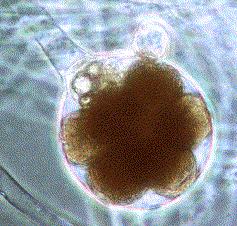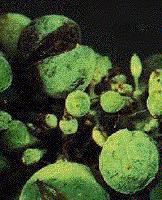Introduction to the Oomycota
Water Molds
There are more than 500 species in the Oomycota -- these include the
so-called water molds and downy mildews. They are filamentous
protists
which must absorb their food from the surrounding water or soil, or may
invade the body of another organism to feed. As such, oomycetes play an
important role in the decomposition and recycling of decaying matter. Other
parasitic species have caused much human suffering through destruction of
crops and fish.
 "Oomycota" means "egg fungi," and refers to the large round
oogonia, or structures containing the female gametes, as shown in
this picture of the common "water mold" Saprolegnia. Oomycetes
are oogamous, producing large non-motile gametes called eggs, and
smaller gametes called sperm.
"Oomycota" means "egg fungi," and refers to the large round
oogonia, or structures containing the female gametes, as shown in
this picture of the common "water mold" Saprolegnia. Oomycetes
are oogamous, producing large non-motile gametes called eggs, and
smaller gametes called sperm.
The Oomycota have a very sparse fossil record. A possible oomycete has been
described from Cretaceous amber.
Water molds were once thought to be fungi.
The Oomycota were once classified as
fungi,
because of their filamentous growth, and because they feed on decaying
matter like fungi. The cell wall of oomycetes, however, is not composed of
chitin, as in the fungi, but is made up of a mix of cellulosic
compounds and glycan. The nuclei within the filaments are diploid,
with two sets of genetic information, not haploid as in the fungi.
The ultrastructure, biochemistry, and molecular sequences of these
organisms indicate that they belong with the
Chromista.
The free-swimming spores which are produced bear two dissimilar
flagella, one with mastigonemes; this feature is common in the
chromists, as is the presence of the chemical mycolaminarin, an
energy storage molecule similar to those found in kelps and diatoms. Thus,
although oomycetes are in the minority as heterotrophic chromists, they
quite definitely belong with these other chromist groups.
Parasitic water molds damage fish and many crop plants.
Some water molds are parasites on other organisms; they may grow
on the scales or eggs of
fish, or
on amphibians. The water mold Saprolegnia causes lesions
on fish which cause problems when the water is rather stagnant, as in aquaria
or fish farms, or at high population densities, such as when salmon swim
upstream to spawn. Other species of Saprolegnia are
parasitic on aquatic invertebrates such as rotifers, nematodes, and
arthropods, and on diatoms.
Their greatest impact on humans, however, comes from the many species of
water mold which are parasites on flowering plants. These include root
rotting fungi, seedling dampening mold, blister rusts, white rusts
(Albugo), and the downy mildews that affect grapes,
lettuce, corn, cabbage, and many other crop plants. Two of these
disease-causing chromists have had a major impact on world history.
The first of these is Phytophthora infestans, the organism
which causes late blight of potato. The potato is native to North America,
but once it was introduced to Europe, it quickly became an important food
crop. Late blight did not follow its host plant across the Atlantic until much
later; the disease organism grows into the stem and leaf tissues, causing
death, and may also infest the tubers, which are the part of the plant
that is eaten. The disease spreads rapidly under cool and damp conditions,
which are common in western Europe. In one week during the summer of
1846, this diease wiped out almost the entire potato crop of Ireland, a crop
which was the primary food of the poor at that time. Nearly a million Irish
died in the Great Famine,
and an additional one-and-a-half million
emigrated to other countries, including America. Thus, if you are an
American with Irish ancestry, it was probably the oomycetes that brought
your family here. Other species of Phytophthora destroy
eucalyptus, avocado, pineapples, and other tropical crop plants.
 The other oomycete which has severely impacted recent history is
pictured at right --
Plasmopara viticola, the downy mildew of grapes. It also is
a native of North America, but in the late 1870s was accidentally introduced
to Europe. At the time, the French wine industry was concerned over a
massive aphid infestation, and so brought resistant vine strains over from
America to breed them into their own grapes. When these American stocks
arrived, they also brought the downy mildew, which almost wiped out the
entire French wine industry. The industry was saved by the serendipitous
discovery of Bordeaux mixture, a mixture of lime and copper sulfate, which
brought the disease under control when applied to the leaves of the plants.
This discovery is also important for being the first known fungicide, and in
fact the first chemical used to control a plant disease.
The other oomycete which has severely impacted recent history is
pictured at right --
Plasmopara viticola, the downy mildew of grapes. It also is
a native of North America, but in the late 1870s was accidentally introduced
to Europe. At the time, the French wine industry was concerned over a
massive aphid infestation, and so brought resistant vine strains over from
America to breed them into their own grapes. When these American stocks
arrived, they also brought the downy mildew, which almost wiped out the
entire French wine industry. The industry was saved by the serendipitous
discovery of Bordeaux mixture, a mixture of lime and copper sulfate, which
brought the disease under control when applied to the leaves of the plants.
This discovery is also important for being the first known fungicide, and in
fact the first chemical used to control a plant disease.
This picture of
Saprolegnia
may be viewed as part of the
Botanical Images Database
of the University of Wisconsin: our thanks to them.
Images of diseased plants, such as the Plasmopara picture, are displayed at the
Department of Crop Science at the University of Guelph, in Canada.
For more information about oomycete diseases of plants, try the
Texas Plant Disease Handbook maintained by the Department of
Plant Pathology and Microbiology
at Texas A&M, the
Plant Pathology Catalog
created by the North Carolina Cooperative Extension Service, and the
Kansas State University
Department of Plant Pathology.

Sources:
Sleigh, M.A. 1989. Protozoa and Other Protists. Edward Arnold, London.
Handbook of Protoctista, ed. by L. Margulis et al., 1990
Jones and Bartlett, chapter 33 by Michael W. Dick.


 "Oomycota" means "egg fungi," and refers to the large round
oogonia, or structures containing the female gametes, as shown in
this picture of the common "water mold" Saprolegnia. Oomycetes
are oogamous, producing large non-motile gametes called eggs, and
smaller gametes called sperm.
"Oomycota" means "egg fungi," and refers to the large round
oogonia, or structures containing the female gametes, as shown in
this picture of the common "water mold" Saprolegnia. Oomycetes
are oogamous, producing large non-motile gametes called eggs, and
smaller gametes called sperm.



